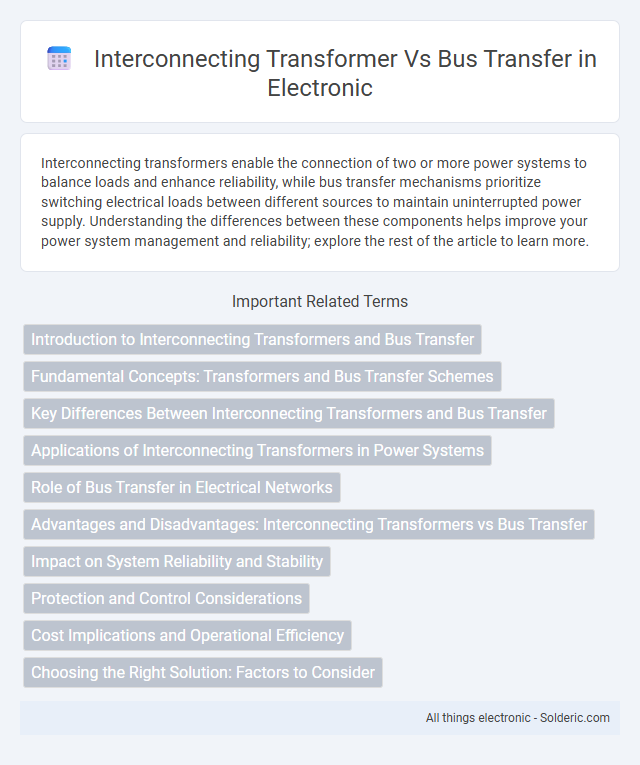Interconnecting transformers enable the connection of two or more power systems to balance loads and enhance reliability, while bus transfer mechanisms prioritize switching electrical loads between different sources to maintain uninterrupted power supply. Understanding the differences between these components helps improve your power system management and reliability; explore the rest of the article to learn more.
Comparison Table
| Feature | Interconnecting Transformer | Bus Transfer |
|---|---|---|
| Function | Connects two electrical systems to share power and balance load | Switches load between different power sources or buses |
| Primary Use | Power system stability and load sharing | Power source selection and backup supply |
| Operation | Continuous electrical connection through transformer coupling | Discrete switching operation to transfer load |
| Impact on Power Quality | Regulates voltage and reduces transient effects | Potential momentary power interruption during transfer |
| Installation Complexity | Requires transformer installation and coordination | Simple switching mechanism installation |
| Cost | Higher due to transformer and control equipment | Lower, mainly switching devices |
| Typical Applications | Power grids, industrial plants for load sharing | Emergency backup, automatic transfer switches in buildings |
Introduction to Interconnecting Transformers and Bus Transfer
Interconnecting transformers enable the seamless connection of separate electrical systems, enhancing reliability and load sharing by balancing voltage and phase differences. Bus transfer mechanisms facilitate the switching between power sources, ensuring continuous power supply during faults or maintenance by automatically or manually transferring loads. Both technologies play crucial roles in optimizing power distribution and minimizing downtime in electrical networks.
Fundamental Concepts: Transformers and Bus Transfer Schemes
Transformers interconnect electrical systems by adjusting voltage levels, enabling efficient power distribution and system stability, whereas bus transfer schemes focus on switching loads between power sources to ensure continuous supply. Interconnecting transformers serve as a bridge between grid sections, managing impedance and phase alignment, while bus transfer schemes provide rapid transfer capabilities to maintain power during source failures. Understanding both concepts helps optimize your power system's reliability and flexibility by combining voltage transformation with seamless source transfer.
Key Differences Between Interconnecting Transformers and Bus Transfer
Interconnecting transformers primarily link electrical systems with different voltage levels, enabling power flow and voltage transformation, while bus transfer switches facilitate the transfer of electrical loads between two power sources without transformation. Interconnecting transformers manage phase angle shifts and voltage regulation, whereas bus transfer systems ensure seamless load switching to maintain power continuity during source changes. Key differences also include their operational roles: transformers modify electrical parameters for system compatibility, while bus transfer switches prioritize reliability and minimal interruption in power supply.
Applications of Interconnecting Transformers in Power Systems
Interconnecting transformers facilitate the transfer of electrical power between different voltage levels and grids, ensuring system stability and interoperability in complex power networks. They are essential in integrating renewable energy sources, supporting load balancing, and enabling parallel operation of independent power systems. Their application enhances fault isolation, improves voltage regulation, and optimizes power flow control across interconnected transmission and distribution networks.
Role of Bus Transfer in Electrical Networks
Bus transfer plays a critical role in electrical networks by enabling seamless switching of power sources without interrupting the load. It ensures continuous power supply during maintenance or fault conditions, enhancing system reliability and operational flexibility. Effective bus transfer mechanisms minimize downtime and reduce the risk of outages in complex power distribution systems.
Advantages and Disadvantages: Interconnecting Transformers vs Bus Transfer
Interconnecting transformers offer advantages such as improved voltage regulation and fault isolation, enhancing system reliability during power fluctuations, but they can be costly and complex to maintain. Bus transfer provides a simpler method for switching loads between power sources quickly, minimizing downtime, though it may lead to transient disturbances and less effective fault isolation. Your choice depends on balancing the need for system stability against installation and operational complexities.
Impact on System Reliability and Stability
Interconnecting transformers enhance system reliability and stability by providing continuous power flow and minimizing disruption during faults or maintenance, unlike bus transfer systems that can cause temporary outages during switching operations. Your electrical network benefits from the transformer's ability to isolate faults and balance load, reducing voltage fluctuations and preventing cascading failures. This improved fault tolerance and load management significantly contribute to maintaining a stable and reliable power supply.
Protection and Control Considerations
Interconnecting transformers require advanced protection schemes such as differential relays and overcurrent protection to manage fault currents and prevent transformer damage, while bus transfer systems prioritize rapid transfer logic and synchronization to ensure seamless switching between power sources without interruption. Transformer protection often involves monitoring for issues like winding faults, inrush currents, and thermal overloads, whereas bus transfer control emphasizes breaker status, load balancing, and transfer time optimization. Both systems necessitate coordination between protection relays and control devices to maintain system stability and minimize outage risks during switching operations.
Cost Implications and Operational Efficiency
Interconnecting transformers typically involve higher initial capital expenditure due to complex installation and equipment costs compared to bus transfer systems, which are generally more cost-effective for straightforward load switching. Operational efficiency favors interconnecting transformers by enabling seamless load sharing, improved reliability, and reduced downtime through automatic fault isolation. In contrast, bus transfer systems offer simpler operations but may result in longer outage periods and less flexibility during maintenance or fault conditions.
Choosing the Right Solution: Factors to Consider
Evaluating interconnecting transformer versus bus transfer requires assessing load capacity, system reliability, and cost efficiency. Interconnecting transformers optimize voltage regulation and reduce system losses, while bus transfers provide faster switching and simpler maintenance for emergency power scenarios. Your decision should balance peak load demands, outage response time, and long-term operational expenses to select the most effective power distribution strategy.
interconnecting transformer vs bus transfer Infographic

 solderic.com
solderic.com